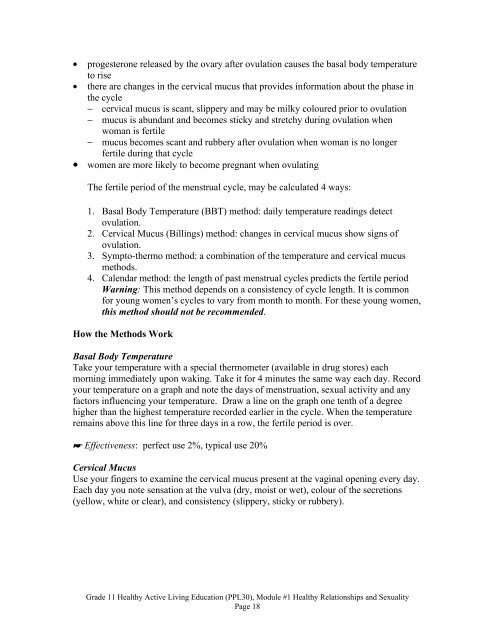Grade 11 Healthy Active Living Education Additional Supports ...
Grade 11 Healthy Active Living Education Additional Supports ...
Grade 11 Healthy Active Living Education Additional Supports ...
Create successful ePaper yourself
Turn your PDF publications into a flip-book with our unique Google optimized e-Paper software.
• progesterone released by the ovary after ovulation causes the basal body temperature<br />
to rise<br />
• there are changes in the cervical mucus that provides information about the phase in<br />
the cycle<br />
− cervical mucus is scant, slippery and may be milky coloured prior to ovulation<br />
− mucus is abundant and becomes sticky and stretchy during ovulation when<br />
woman is fertile<br />
− mucus becomes scant and rubbery after ovulation when woman is no longer<br />
fertile during that cycle<br />
• women are more likely to become pregnant when ovulating<br />
The fertile period of the menstrual cycle, may be calculated 4 ways:<br />
1. Basal Body Temperature (BBT) method: daily temperature readings detect<br />
ovulation.<br />
2. Cervical Mucus (Billings) method: changes in cervical mucus show signs of<br />
ovulation.<br />
3. Sympto-thermo method: a combination of the temperature and cervical mucus<br />
methods.<br />
4. Calendar method: the length of past menstrual cycles predicts the fertile period<br />
Warning: This method depends on a consistency of cycle length. It is common<br />
for young womenÕs cycles to vary from month to month. For these young women,<br />
this method should not be recommended.<br />
How the Methods Work<br />
Basal Body Temperature<br />
Take your temperature with a special thermometer (available in drug stores) each<br />
morning immediately upon waking. Take it for 4 minutes the same way each day. Record<br />
your temperature on a graph and note the days of menstruation, sexual activity and any<br />
factors influencing your temperature. Draw a line on the graph one tenth of a degree<br />
higher than the highest temperature recorded earlier in the cycle. When the temperature<br />
remains above this line for three days in a row, the fertile period is over.<br />
* Effectiveness: perfect use 2%, typical use 20%<br />
Cervical Mucus<br />
Use your fingers to examine the cervical mucus present at the vaginal opening every day.<br />
Each day you note sensation at the vulva (dry, moist or wet), colour of the secretions<br />
(yellow, white or clear), and consistency (slippery, sticky or rubbery).<br />
<strong>Grade</strong> <strong>11</strong> <strong>Healthy</strong> <strong>Active</strong> <strong>Living</strong> <strong>Education</strong> (PPL30), Module #1 <strong>Healthy</strong> Relationships and Sexuality<br />
Page 18
















